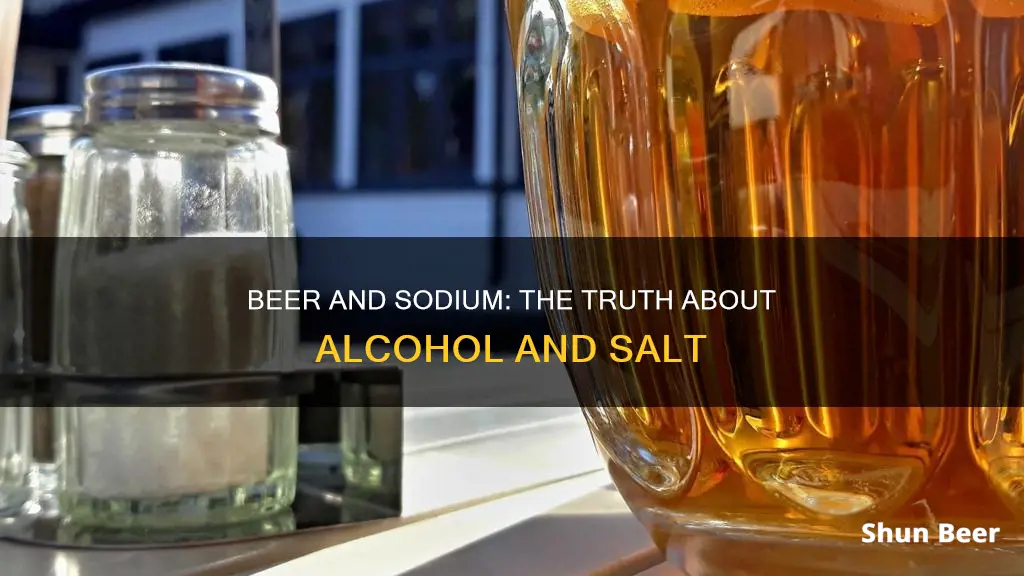
Drinking beer excessively without consuming adequate food can lead to a condition called beer potomania or beer drinker's hyponatremia, which is characterised by abnormally low sodium levels in the blood. This condition is a result of the combination of malnutrition and binge drinking, causing an imbalance between sodium and water levels in the body. While beer contains a lot of water, it has very little sodium, and this disproportionate ratio can lead to hyponatremia, especially when coupled with a diet low in sodium and protein-rich foods.
| Characteristics | Values |
|---|---|
| What is Potomania? | Excessive drinking of beer and poor diet |
| What does it cause? | Hyponatremia (lack of sodium in the blood) |
| What are the symptoms? | Difficulty concentrating, lethargy, irritability, muscle cramps, loss of consciousness, coma |
| What is the treatment? | No food or drink for 24 hours, IV fluids, careful monitoring of sodium levels, oxygen |
| How can it be prevented? | Healthy diet, reduction or avoidance of alcohol |
What You'll Learn

Beer contains a lot of water and little sodium
Beer contains a lot of water and only a little sodium. This lopsided water-to-salt ratio can lead to a condition known as "beer potomania" or "beer drinker's hyponatremia", in which the level of sodium in the bloodstream drops too low due to excessive beer consumption and inadequate sodium-rich food intake.
The high water content and low sodium content of beer can cause fluid buildup in the cells, as there is not enough sodium in the body to maintain the balance between sodium and water levels. This fluid buildup can lead to swelling in the body's tissues and, if left untreated, can be life-threatening.
The risk of developing beer potomania is higher in individuals with chronically low sodium levels who engage in binge drinking while also having poor overall nutrition. The kidneys can become dysfunctional, and the sodium in the bloodstream becomes diluted by the extra water, leading to a rapid drop in sodium levels.
Treating beer potomania requires a careful approach, as rapid reversal of sodium levels can lead to neurological problems such as osmotic demyelination syndrome (ODS). Doctors recommend a slow and careful administration of sodium over 48 hours to avoid these complications.
While beer contains a lot of water, the amount of sodium present can vary depending on the brewing process and the type of beer. Darker, full-bodied styles like stouts and porters may have higher sodium levels, while delicate beers like lagers and pilsners typically have lower levels. However, even with the highest sodium content, beer still contains relatively little sodium compared to other foods or beverages.
Beer and Breathing: Is Your Beverage Affecting Your Lungs?
You may want to see also

Sodium is an important nutrient
One of sodium's primary functions is to control the amount and distribution of water in our bodies, which in turn helps regulate blood pressure. Sodium achieves this by creating specific channels in the membranes of our cells, which allow water and specific nutrients to enter and exit. This process is known as osmosis. Sodium also interacts with chloride and potassium to help regulate water volume in the body and support the normal function of muscle and nerve cells.
In addition to its role in water balance, sodium is essential for the excitability of muscle and nerve cells. It helps our muscles and heart contract and enables our nerve cells to carry messages (nerve impulses) between the brain and the body. This is why a severe lack of sodium can lead to neurological symptoms such as altered mental state, muscle weakness, spasms, irritability, and even coma.
While sodium is crucial for our bodies, it is important to maintain a healthy balance. Most people get enough sodium from their diet, but it is possible to have too much. Excess sodium is typically a result of a high intake of packaged and prepared foods, as well as adding salt during cooking or at the table. A high-sodium diet can lead to increased blood volume and blood pressure, which can have negative health consequences such as hypertension, heart disease, and stroke. Therefore, it is recommended that adults limit their sodium intake to less than 2,300 milligrams per day, which is equivalent to about one teaspoon of table salt.
Beer and Acid Reflux: Is There a Link?
You may want to see also

Sodium helps regulate water balance in the body
Sodium is an important electrolyte that helps regulate the balance of water in the body. It is the principal cation of the extracellular space, and the body's extracellular fluid volume is almost totally related to sodium handling.
The body maintains homeostasis by protecting sodium balance more vigorously than it does water balance or acid-base balance. Sodium balance occurs when sodium intake equals sodium loss. The kidneys are the most important homeostatic control point for both sodium and water. The body's endocrine system, a complex chemical messaging system made up of feedback loops of hormones, regulates the balance of sodium and water.
Sodium and water travel together, and their "saltiness" must be tightly regulated. Their balance is ultimately found in the kidney, with feedback to the kidney coming from "pressure and saltiness" receptors in the heart, blood vessels, kidneys, and brain.
The body's sodium and water balance is regulated by the interaction of numerous neurohormonal mechanisms, including the renin-angiotensin-aldosterone system, the sympathetic nervous system, and the presence of atrial natriuretic peptide and brain natriuretic peptide. In addition, sodium regulation is closely correlated with the body's effective circulating volume (ECV), defined as the intravascular volume needed to provide adequate tissue perfusion. As a result, the major determinant of serum sodium is, in fact, the serum water content.
Beer and Thrush: Is There a Connection?
You may want to see also

Excessive beer consumption can lead to hyponatremia
The first case of severe hyponatremia from excessive beer consumption was reported in 1972, and the condition has since been referred to as "beer potomania" or "beer drinker's hyponatremia". Those with alcoholism or alcohol use disorder are particularly at risk, as they may subsist solely on beer for days, resulting in extremely low sodium intake. Additionally, the kidneys require a certain amount of sodium to function properly and excrete excess fluids. Without enough sodium, the kidneys become dysfunctional, leading to a build-up of fluid in the body's cells, including the brain, which can cause neurological symptoms.
The symptoms of beer potomania include an altered mental state, muscle weakness or cramps, fatigue, irritability, restlessness, and in severe cases, loss of consciousness or coma. Treatment for this condition can be tricky, as rapid reversal of sodium levels can lead to neurological problems such as osmotic demyelination syndrome (ODS). Therefore, a slow and careful administration of sodium is recommended over the course of 48 hours.
To prevent beer potomania, it is important to maintain a healthy and nutritious diet and reduce or avoid alcohol intake. Seeking help for alcohol addiction is crucial, as it can lead to many life-threatening conditions, including beer potomania.
Beer and Acid: A Safe Mix?
You may want to see also

Hyponatremia can be life-threatening
Drinking beer does not directly remove sodium from the body. However, beer contains a lot of water and only a little sodium, so drinking a lot of beer without eating enough sodium-rich foods can lead to a condition called "beer potomania" or "beer drinker's hyponatremia". Hyponatremia is the medical term for abnormally low sodium levels in the blood.
Hyponatremia can be dangerous and even life-threatening. Sodium is an important electrolyte that helps regulate the balance of water in the body and is needed for nerves, muscles and other body tissues to function properly. When sodium levels drop, the amount of water in the body rises, causing cells to swell. Brain cells are especially sensitive to this swelling, which can lead to neurological symptoms such as:
- Acutely altered mental state
- Muscle weakness, spasms or cramps
- Fatigue
- Irritability or restlessness
- Seizures
- Coma
- Death
The speed at which sodium levels drop is a key factor in the severity of hyponatremia. When sodium levels fall slowly over several days or weeks, symptoms may be mild. However, if sodium levels drop within 24 to 48 hours, serious complications such as severe cerebral edema, coma or brainstem herniation can occur. Acute hyponatremia, where sodium levels drop very quickly, can cause rapid brain swelling and increase the risk of brain damage. This is more likely to occur in pre-menopausal women due to the effect of female sex hormones on sodium levels.
Treating hyponatremia can be challenging as a rapid reversal of sodium levels can lead to a condition called osmotic demyelination syndrome (ODS), which can cause permanent neurological damage. Therefore, doctors recommend slowly increasing sodium levels over a period of 48 hours.
Golfers and Beer: Is It a Hole-in-One Combination?
You may want to see also
Frequently asked questions
"Beer removes sodium from the body" is a phrase used to refer to the condition called "beer potomania" or "hyponatremia", which is caused by excessive beer consumption and inadequate sodium and protein-rich food intake. This condition leads to a dangerously low level of sodium in the blood.
Hyponatremia is the medical term for abnormally low sodium levels in the blood. It can be caused by various conditions, including excessive water consumption, and can lead to water intoxication, where neuropsychiatric issues occur due to the body having more water than it can handle.
Symptoms of beer potomania include altered mental state, muscle weakness or cramps, fatigue, irritability, restlessness, and in severe cases, loss of consciousness or coma.
Beer has a high water content and a low sodium content. When individuals with chronically low sodium levels binge on beer, especially when combined with poor nutrition, their kidneys can become dysfunctional. The low sodium levels in beer dilute the sodium in the bloodstream, causing it to drop to severely low levels.
Beer potomania can be prevented by maintaining a healthy and nutritious diet with adequate sodium and protein intake, and reducing or avoiding excessive alcohol consumption.







